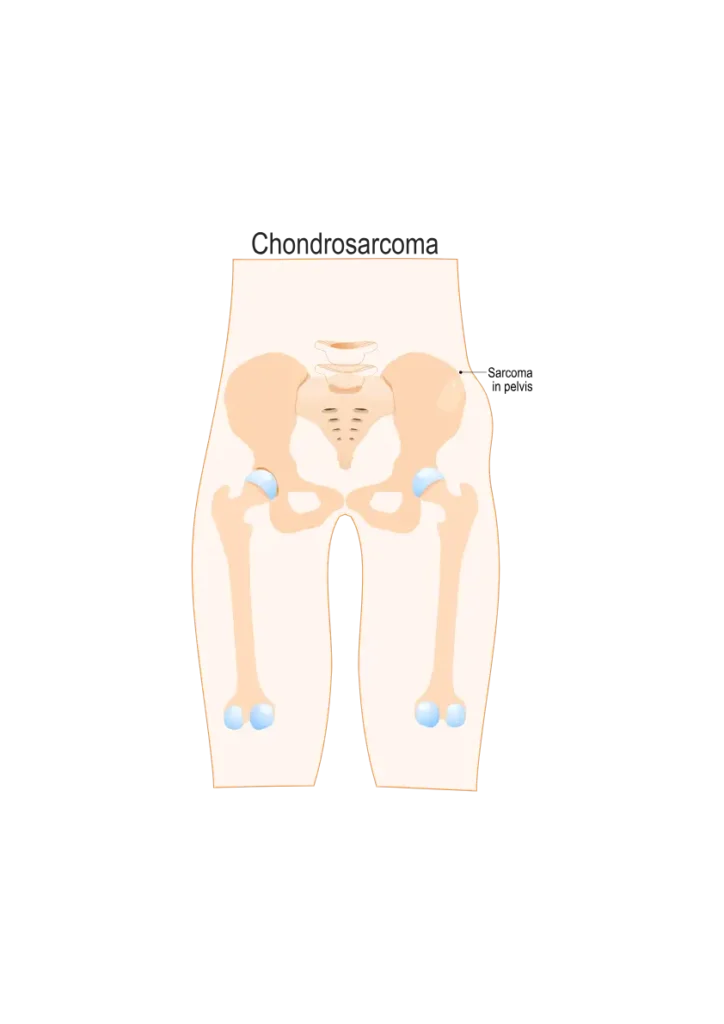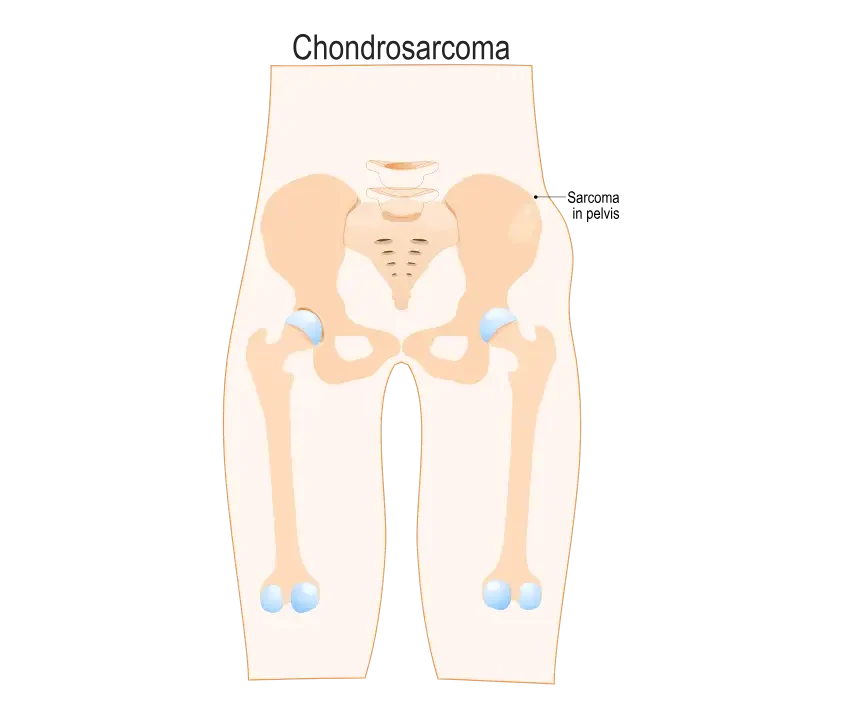Chondrosarcoma Overview
Chondrosarcoma is a type of cancer that forms in the cartilage cells, most commonly affecting the bones of the pelvis, femur, and shoulder. It is known for its slow-growing nature but can be aggressive in some cases. At Fight Bone Tumors, Dr. Kishore B Reddy and our dedicated team provide specialized care for patients with chondrosarcoma, offering advanced diagnostic techniques and personalized treatment plans to effectively manage this challenging condition.
Symptoms:
The symptoms of chondrosarcoma can vary depending on the tumor’s location and size, but common signs include:
- Persistent Pain: Often worse at night and not relieved by rest.
- Swelling or Lump: In the affected area.
- Limited Range of Motion: Especially if the tumor is near a joint.
- Fractures: Weakened bone can lead to fractures with minimal trauma.
Early detection and intervention are key to managing symptoms and improving outcomes.
Diagnosis:
Diagnosis:
Diagnosing chondrosarcoma involves a combination of tests to confirm the presence of the tumor and determine its characteristics:
- Physical Examination: Initial assessment to evaluate symptoms and overall health.
- Imaging Tests: X-rays, MRI, and CT scans to visualize the tumor, assess its size, and determine its location.
- Biopsy: A sample of the tumor tissue is taken and examined under a microscope to confirm the diagnosis and identify the specific type of chondrosarcoma.
Accurate diagnosis is essential for developing an effective treatment plan.
Types of Chondrosarcoma:
There are several subtypes of chondrosarcoma, each with different characteristics:
- Conventional Chondrosarcoma: The most common type, usually found in the pelvis, femur, and shoulder.
- Dedifferentiated Chondrosarcoma: A more aggressive form that includes areas of high-grade sarcoma.
- Clear Cell Chondrosarcoma: A rare, low-grade variant often found in the ends of long bones.
- Mesenchymal Chondrosarcoma: A rare, aggressive type that can occur in both bone and soft tissue.
Understanding the specific type of chondrosarcoma is crucial for choosing the appropriate treatment approach.

Treatment Options:
Treatment for chondrosarcoma is tailored to each patient and may involve a combination of therapies:
Surgery:
- Wide Excision: Removing the tumor along with a margin of healthy tissue to ensure complete removal.
- Limb-Sparing Surgery: Whenever possible, preserving the limb’s function while removing the tumor.
- Amputation: In cases where the tumor is too large or aggressive to remove while preserving the limb.
Radiation Therapy:
- Used in cases where the tumor cannot be completely removed surgically or to target residual cancer cells after surgery.
Chemotherapy:
- Generally less effective for conventional chondrosarcoma but may be used for certain aggressive subtypes like dedifferentiated or mesenchymal chondrosarcoma.
Our multidisciplinary team collaborates to develop personalized treatment plans aimed at achieving the best possible outcomes for our patients.
Support and Rehabilitation:
Dealing with chondrosarcoma involves more than just medical treatment. We offer comprehensive support services to help patients and their families through this journey:
Physical Therapy:
- Essential for recovery post-surgery, aiding in regaining strength and mobility.
Emotional Support:
- Counseling and support groups to address the emotional and psychological impacts of living with chondrosarcoma.
Nutritional Guidance:
- Tailored dietary plans to support overall health and recovery during and after treatment.
Follow-Up Care:
- Regular check-ups to monitor for recurrence and manage any long-term side effects of treatment.
FAQ's
Chondrosarcoma is a type of cancer that forms in the cartilage cells, most commonly affecting the bones of the pelvis, femur, and shoulder. It is known for its slow-growing nature but can be aggressive in some cases.
Common symptoms include persistent pain, swelling or a lump, limited range of motion, and fractures.
Diagnosis typically involves a physical examination, imaging tests (X-rays, MRI, CT scans), and a biopsy to confirm the diagnosis and identify the specific type of chondrosarcoma.
Treatment options may include surgery (wide excision, limb-sparing surgery, amputation), radiation therapy, and chemotherapy for certain aggressive subtypes.
Wide excision surgery involves removing the tumor along with a margin of healthy tissue to ensure complete removal and reduce the risk of recurrence.
Yes, potential side effects can include pain, swelling, risk of infection, and challenges related to rehabilitation post-surgery. Specific treatments may have their own unique side effects.
Managing side effects can involve rest, physical therapy, proper nutrition, pain management medications, and emotional support through counseling or support groups.
We offer physical therapy, emotional support, nutritional guidance, and regular follow-up care to monitor for recurrence and manage long-term side effects.
With early detection and appropriate treatment, many patients can achieve long-term remission. The prognosis depends on the type, size, and location of the tumor, as well as the effectiveness of the treatment.
You can schedule a consultation by calling us at +91 9032027279 or emailing info@fightbonetumors.com. Our team is here to provide personalized care and support.





